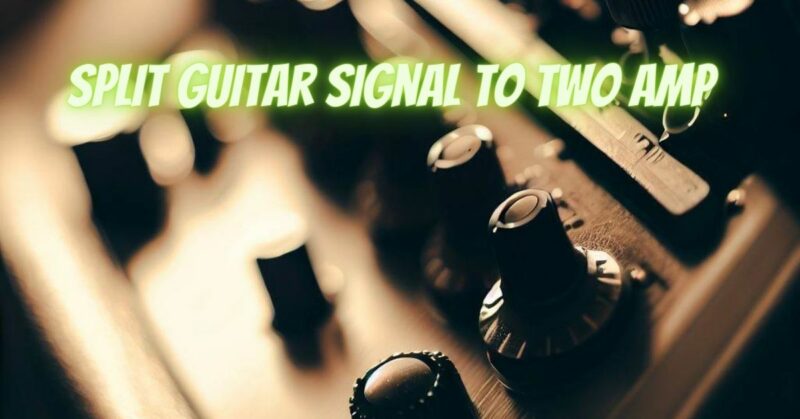If you’re looking to broaden your sonic horizons and add more depth and dimension to your guitar sound, splitting your guitar signal to two amplifiers can be a game-changer. This technique allows you to simultaneously route your guitar signal to two separate amplifiers, opening up a world of tonal possibilities and sonic flexibility. In this article, we will explore the process of splitting your guitar signal to two amps, the benefits it offers, and the different methods you can use to achieve this setup.
Why Split Your Guitar Signal?
- Expanded Tonal Palette: By splitting your guitar signal to two amplifiers, you can create a fuller and richer sound. Each amplifier can be dialed in differently, allowing you to shape the tone, add effects, or apply different amp settings. This opens up a range of possibilities, from creating a stereo spread to blending clean and distorted tones.
- Enhanced Sonic Depth and Dimension: Splitting your guitar signal to two amps adds depth and dimension to your sound. You can achieve a wider stereo image, with one amp panned left and the other panned right, providing a more immersive and spacious sonic experience.
Methods for Splitting Your Guitar Signal:
- ABY Switch: An ABY switch is a device specifically designed for splitting your guitar signal to two amplifiers. It allows you to route your guitar signal to either amp individually or to both amps simultaneously. The ABY switch often includes various routing options, such as A/B, A+B, or even a buffered output to maintain signal integrity.
- Effects Loop: Some amplifiers have an effects loop that can be used to split your guitar signal. By connecting the “send” of the effects loop to one amplifier and the “return” to another, you can achieve a split signal. Keep in mind that this method requires amplifiers with an effects loop and may introduce additional considerations such as impedance matching.
- Y-Cable: A Y-cable is a simple and cost-effective method to split your guitar signal. It involves using a cable with a single mono 1/4″ connector on one end and two mono 1/4″ connectors on the other end. You can plug one end into your guitar and connect the other ends to each amplifier’s input.
- Line-Level Splitter: A line-level splitter, often used in studio settings, allows you to split your guitar signal with greater control. This device provides isolation and impedance matching, minimizing signal degradation and potential interference. It typically offers multiple outputs for connecting to multiple amplifiers or audio interfaces.
Considerations and Tips:
- Impedance Matching: Ensure that the impedance of your amplifiers matches the output impedance of your guitar or the splitter device you are using. Mismatched impedances can result in tone loss, signal degradation, or even damage to your equipment.
- Grounding and Noise: When splitting your guitar signal, it’s important to pay attention to grounding and potential noise issues. Use high-quality cables, check for ground loop hums, and consider using noise gates or other noise reduction techniques to maintain a clean signal.
- Stereo Amplification: If you’re aiming for a stereo setup, ensure that each amplifier has a distinct panning position to create a balanced stereo spread. Experiment with different EQ settings, effects, and amp characteristics to achieve the desired tonal balance.
- Experiment and Have Fun: Splitting your guitar signal to two amplifiers opens up a world of creative possibilities. Experiment with different combinations of amps, settings, and effects to find the unique sound that suits your style and musical preferences.
Splitting your guitar signal to two amplifiers provides an exciting avenue for tonal exploration and sonic versatility. Whether you use an ABY switch, effects loop, Y-cable, or line-level splitter, the ability to shape your tone, create stereo spreads, or blend different amp characteristics can significantly enhance your guitar playing experience. With careful consideration of impedance matching, grounding, and noise control, you can achieve a dual amplifier setup that adds depth, dimension, and an expanded tonal palette to your playing. So go ahead, split your guitar signal, and let your creativity soar as you explore the world of dual amplification.


